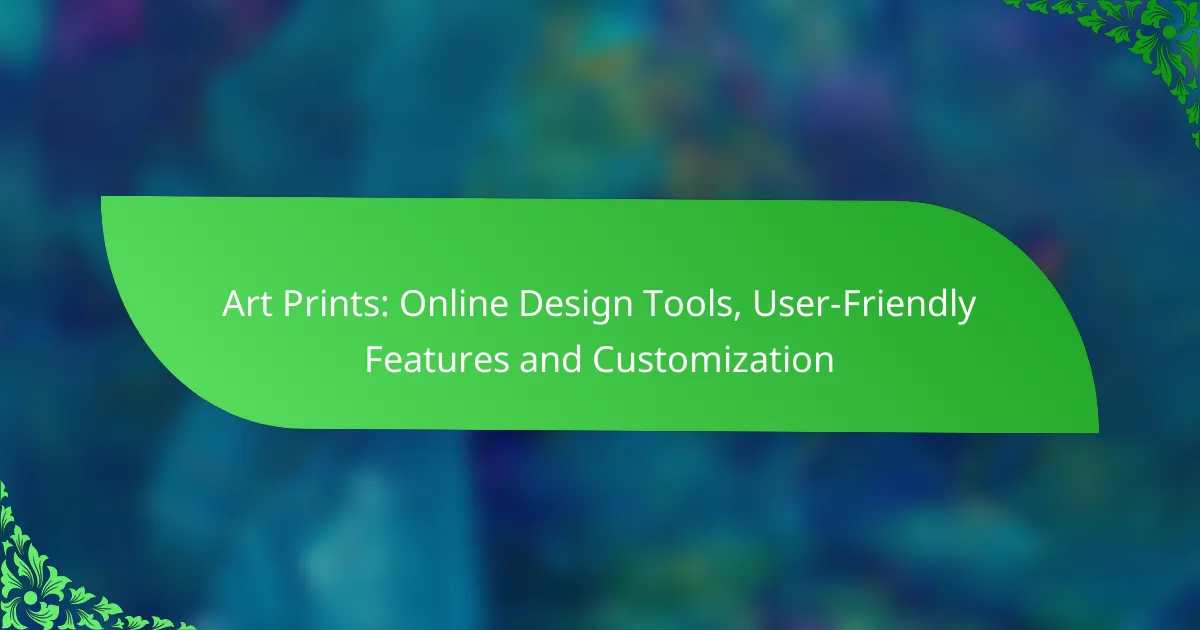Creating art prints online has never been easier, thanks to user-friendly design tools that offer a wealth of customization options. These platforms typically feature intuitive interfaces, drag-and-drop functionality, and a variety of templates, enabling artists to craft unique pieces that reflect their personal style. By prioritizing usability and effective preview options, users can streamline their design process and bring their creative visions to life.

What are the best online design tools for art prints?
The best online design tools for art prints combine user-friendly features with customization options, allowing artists and designers to create unique prints easily. These tools often include templates, drag-and-drop interfaces, and a variety of design elements to enhance creativity.
Canva
Canva is a popular online design tool that offers a wide range of templates specifically for art prints. Users can easily customize designs by dragging and dropping elements, adjusting colors, and adding text.
With a free version available, Canva also provides premium features for a subscription fee. This makes it accessible for beginners while offering advanced options for more experienced designers.
Adobe Spark
Adobe Spark allows users to create stunning art prints with its intuitive interface and professional-grade features. It provides various templates and design assets that can be tailored to fit individual styles.
Adobe Spark integrates well with other Adobe products, making it a great choice for those already using Adobe Creative Cloud. Users can also share their designs directly to social media or print them through Adobe’s services.
Visme
Visme is a versatile design tool that caters to both infographics and art prints. It offers a library of customizable templates and a user-friendly interface that simplifies the design process.
Visme’s unique features include data visualization tools and the ability to create interactive designs. This can be particularly useful for artists looking to present their work in engaging ways.
Printful
Printful is primarily a print-on-demand service that also offers design tools for creating art prints. Users can upload their designs and customize products like posters and canvas prints directly on the platform.
With no upfront costs, Printful allows artists to sell their prints online without inventory. This makes it an excellent option for those looking to monetize their artwork while maintaining creative control.
Artify
Artify is tailored specifically for artists and designers, providing a range of templates and design elements focused on art prints. Its user-friendly interface makes it easy to create professional-looking designs quickly.
Artify also offers a marketplace feature, allowing users to sell their designs directly through the platform. This can help artists reach a wider audience while simplifying the sales process.
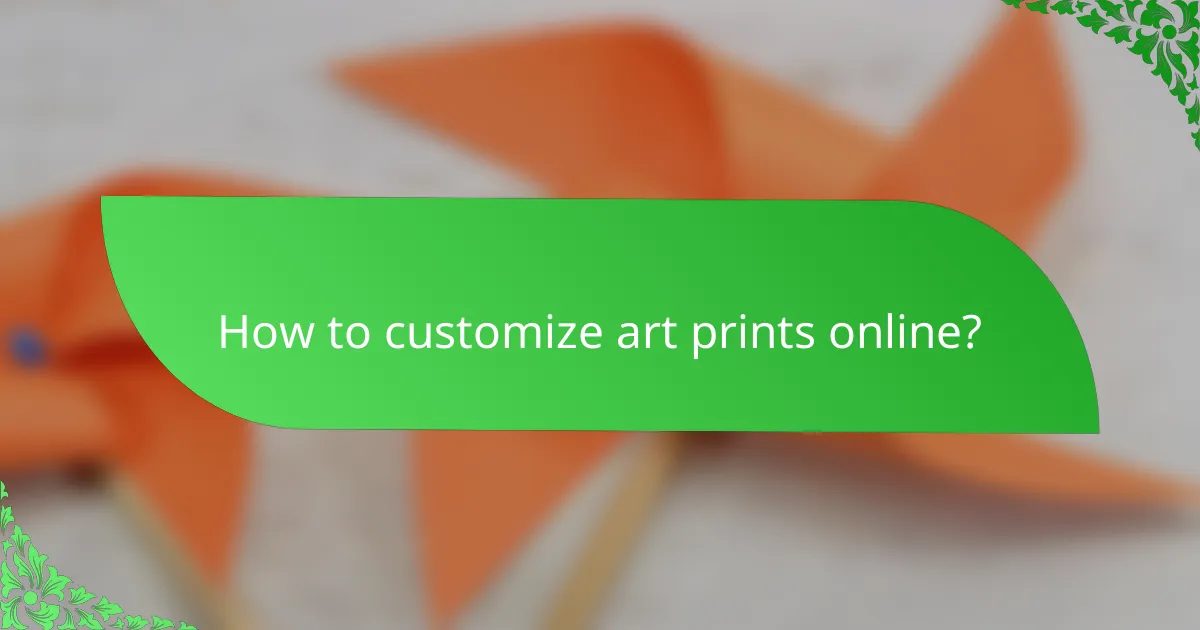
How to customize art prints online?
Customizing art prints online involves using various design tools to create unique pieces that reflect personal style. Key features typically include templates, image uploads, and color adjustments, allowing for a tailored final product.
Using templates
Templates are pre-designed layouts that simplify the customization process for art prints. They often come in various themes and styles, making it easy to find one that suits your vision.
When selecting a template, consider the size and orientation that best fits your intended display area. Many online platforms offer templates specifically designed for standard frame sizes, which can save time and effort.
Adding personal images
Incorporating personal images into your art prints adds a unique touch. Most online design tools allow you to upload photos directly from your device or cloud storage.
Ensure that the images you choose are of high resolution to maintain quality when printed. It’s also wise to check the copyright status of any images you use to avoid potential legal issues.
Adjusting colors and sizes
Adjusting colors and sizes is crucial for achieving the desired look of your art print. Most design platforms provide easy-to-use sliders for color adjustments, allowing you to experiment with different shades and tones.
When resizing, keep in mind the aspect ratio to avoid distortion. Aim for a balance between size and detail, ensuring that the final print is visually appealing and fits well in your chosen space.

What user-friendly features should I look for?
When selecting online design tools for art prints, prioritize features that enhance usability and customization. Look for intuitive interfaces, effective preview options, and compatibility with mobile devices to streamline your design process.
Drag-and-drop interface
A drag-and-drop interface simplifies the design process, allowing users to easily place elements like images and text onto their canvas. This feature is particularly beneficial for those who may not have extensive design experience, as it reduces the learning curve and speeds up the creation process.
When evaluating tools, ensure that the drag-and-drop functionality is responsive and allows for easy adjustments. Look for options that let you resize, rotate, and layer elements without hassle, which can significantly enhance your creative flexibility.
Preview options
Preview options are essential for visualizing how your art print will look once completed. Good design tools offer real-time previews, enabling you to see changes instantly as you modify colors, fonts, or layouts.
Consider tools that provide multiple preview formats, such as mock-ups of the final printed product or digital displays. This can help you make informed decisions about adjustments and ensure that your design meets your expectations before finalizing it.
Mobile compatibility
Mobile compatibility allows you to design art prints on the go, making it easier to work from anywhere. Look for tools that have responsive designs or dedicated mobile apps, ensuring that you can access your projects seamlessly across devices.
Check for features that maintain functionality on mobile, such as drag-and-drop capabilities and preview options. This flexibility can be particularly useful for quick edits or brainstorming sessions while away from your primary workstation.
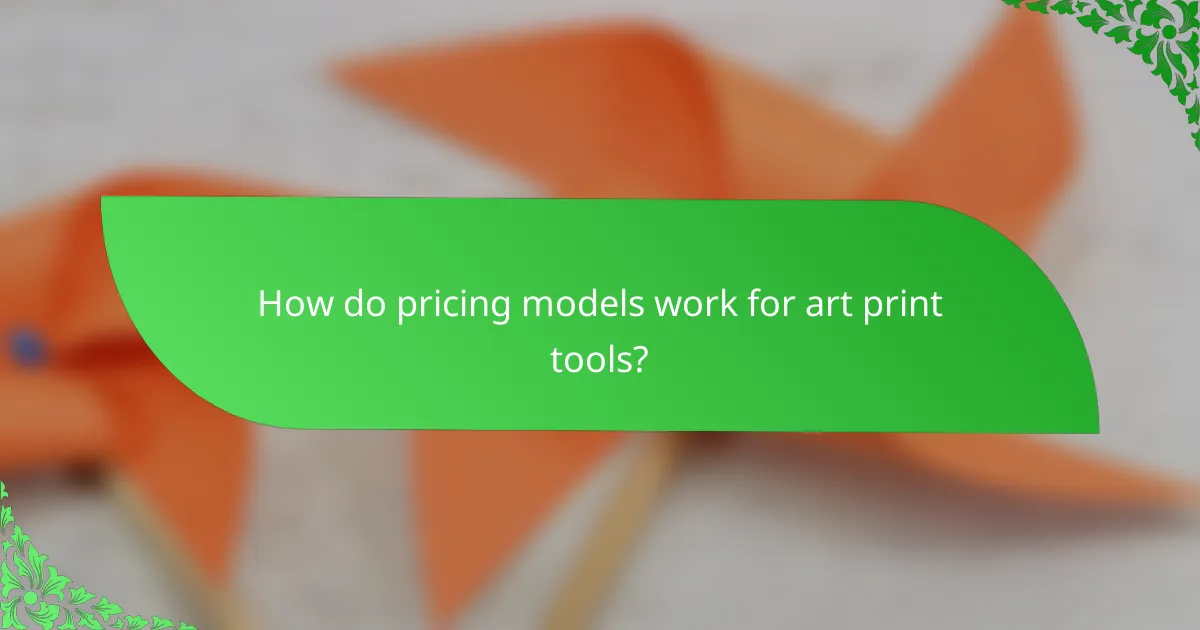
How do pricing models work for art print tools?
Pricing models for art print tools typically include subscription plans, pay-per-print options, and free trials. Each model has its own advantages and considerations, catering to different user needs and budgets.
Subscription plans
Subscription plans generally offer a monthly or annual fee that provides access to a range of features and services. Users can benefit from unlimited prints or discounted rates on individual prints, making this model ideal for artists or businesses that require frequent printing.
When considering a subscription, evaluate the number of prints you anticipate needing. Many platforms offer tiered pricing based on usage, so select a plan that aligns with your expected demand to avoid overspending.
Pay-per-print options
Pay-per-print options allow users to pay for each print individually, which can be cost-effective for occasional users. This model eliminates the commitment of a subscription and is suitable for those who only need prints sporadically.
Keep in mind that costs can vary significantly based on print size, paper quality, and additional features like framing. Always compare the total cost of multiple prints under this model versus a subscription to find the best deal for your needs.
Free trials
Many art print tools offer free trials, allowing users to explore features without financial commitment. These trials typically last for a limited period and may include access to premium features.
Take advantage of free trials to assess the platform’s usability and print quality. Be sure to check the terms, as some trials may automatically convert to paid plans if not canceled in time. This can help you avoid unexpected charges while evaluating your options.
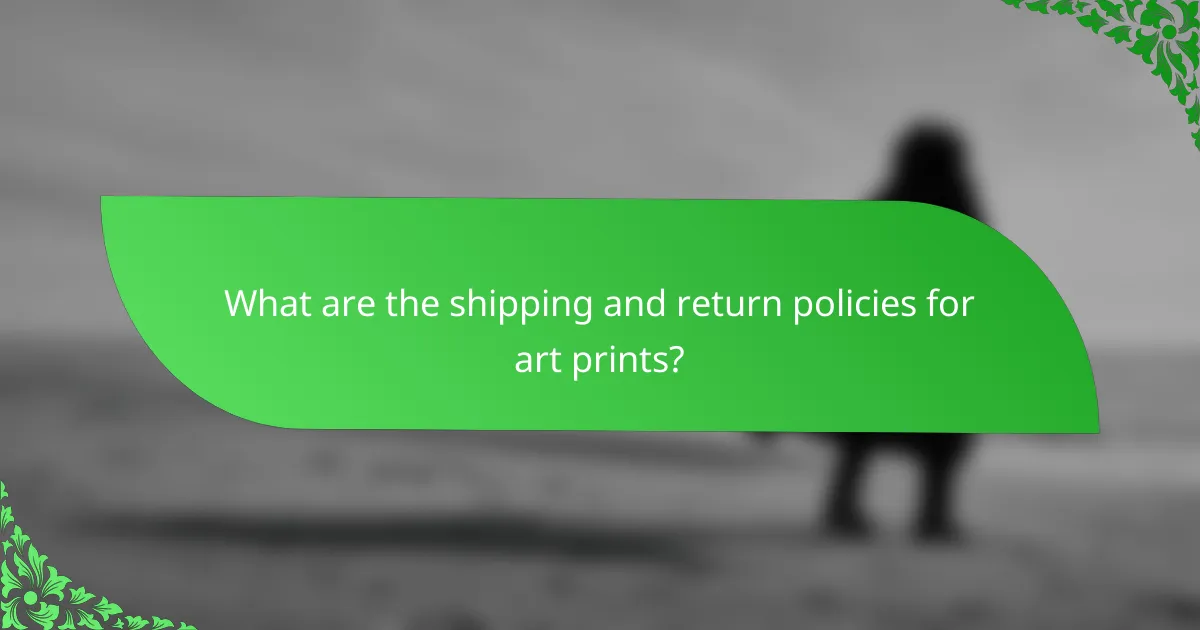
What are the shipping and return policies for art prints?
Shipping and return policies for art prints vary by retailer but generally include standard shipping options and specific return procedures. Most companies offer a satisfaction guarantee, allowing customers to return prints that do not meet their expectations.
Standard shipping rates
Standard shipping rates for art prints typically range from $5 to $15 within the United States, depending on the size and weight of the package. International shipping may incur additional fees, often starting around $20 and increasing based on destination and delivery speed.
Some retailers provide free shipping on orders over a certain amount, usually between $50 and $100. It’s advisable to check the specific shipping policies of each retailer before making a purchase.
Return process overview
The return process for art prints usually involves contacting customer service to initiate a return request. Most retailers require the print to be in its original condition and packaging, and customers often have a window of 14 to 30 days to return items.
To ensure a smooth return, keep the original receipt and any tracking information. Some retailers may provide prepaid return labels, while others might require customers to cover return shipping costs. Always review the specific return policy of the retailer to avoid unexpected fees.
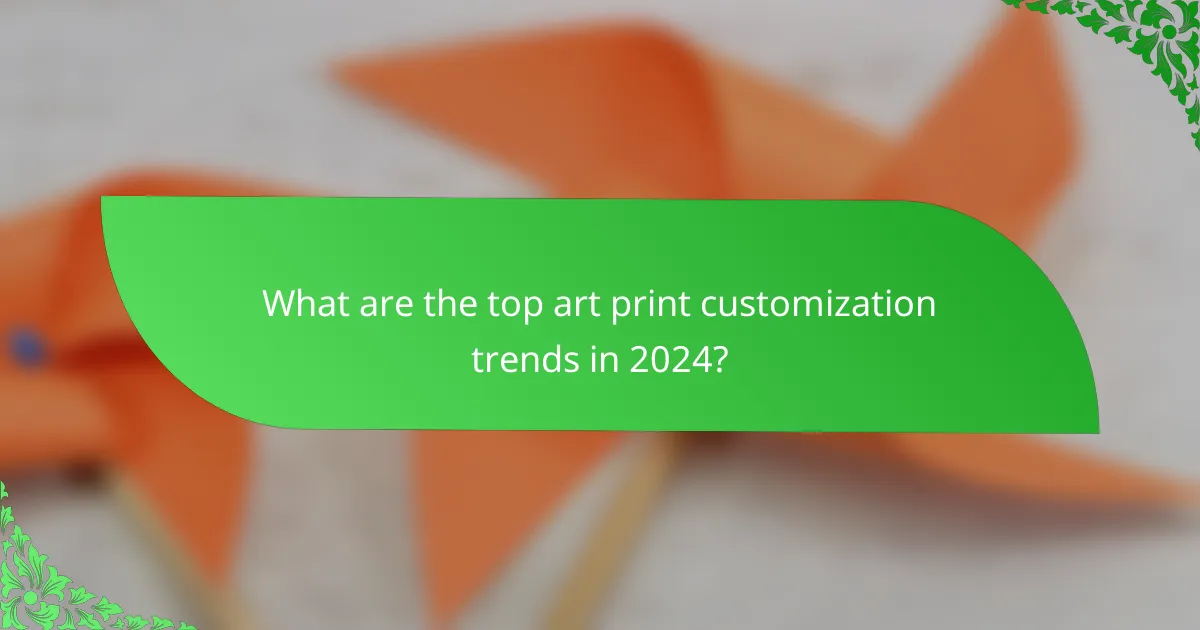
What are the top art print customization trends in 2024?
In 2024, the leading trends in art print customization focus on personalization, sustainability, and advanced technology. Artists and consumers alike are increasingly seeking unique designs that reflect individual tastes while also considering eco-friendly materials and innovative printing techniques.
Personalized Designs
Personalized designs are at the forefront of art print customization. Consumers now prefer artworks that resonate with their personal stories or aesthetics, leading to a rise in custom prints featuring names, dates, or significant imagery. Services that allow users to upload their own images or modify existing designs are particularly popular.
To capitalize on this trend, consider offering tools that let customers easily adjust colors, sizes, and layouts. This flexibility enhances user engagement and satisfaction, making them more likely to share their unique creations.
Sustainable Materials
As environmental awareness grows, the demand for sustainable materials in art prints is increasing. Many consumers are looking for prints made from recycled or eco-friendly materials, which not only reduce waste but also appeal to their values. This trend encourages artists to explore natural inks and sustainable paper options.
When selecting materials, aim for products certified by recognized environmental standards. Highlighting these choices in your marketing can attract eco-conscious buyers and differentiate your offerings in a competitive market.
Advanced Printing Technology
Advanced printing technology is transforming the art print landscape, with innovations such as high-resolution printing and 3D effects becoming more accessible. These technologies allow for more intricate designs and textures, enhancing the overall visual impact of the prints.
Investing in high-quality printers and exploring techniques like UV printing can elevate your product offerings. Additionally, consider providing tutorials or demonstrations to educate customers on the benefits and possibilities of these advanced printing methods.
